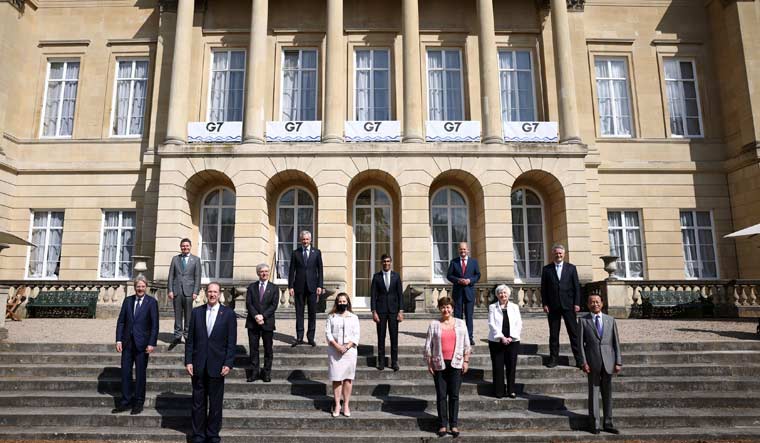The 2021 G7 summit of the world's seven largest, advanced economies—Germany, Italy, Canada, France, Japan, the United Kingdom and the United States—held from June 11-13 in Carbis Bay in Cornwall, on the southwest coast of the UK, has seen the club of the world’s richest democracies returning to a script and setting they are more familiar with. India was also a part of the summit, attending the outreach session along with Australia, South Korea and South Africa.
After four years of tumult and unpredictability headlined by former US president Donald Trump, things were back to normal, and there were hardly any unwelcome surprises at the high table.
The summit clearly showed that the US was well and truly back to its traditional role as the head of the transatlantic alliance. Unlike Trump, who routinely badmouthed the European Union and even threatened to quit NATO, President Joe Biden reassured his European allies about America’s continued commitment to the European cause. The Europeans were appalled when Trump pulled the US out of the Paris climate accord, the Trans-Pacific Partnership, the Iran nuclear deal, and the World Health Organisation. Biden has initiated the process of taking the US back to the global mainstream and the G7 summit was the perfect backdrop to announce that the US was back at the global stage. “The trans-Atlantic alliance is a strong foundation on which our collective security and our shared prosperity are built. The partnership between Europe and the United States, in my view, is and must remain the cornerstone of all that we hope to accomplish in the 21st century, just as we did in the 20th century,” said Biden. And, the cornerstone of his agenda at Cornwall was building a broad coalition against the growing Chinese influence on the global stage.
The China Global Television Network (CGTN), owned by the Chinese Communist Party, carried an op-ed on June 14, saying the joint statement after the G7 summit essentially pushed for a Cold War against China. It was not way off the mark as Biden openly targeted China and Russia at the summit. The US president had come prepared to bury the differences between the US and Europe and tackle his adversaries. He worked hard to resolve a 17-year dispute the US had with the EU over subsidies for aircraft manufacturing, which broke out in 2004 over government subsidies that Europe provides to Airbus. After intense negotiations, both sides agreed to suspend the implementation of $11.5 billion in tariffs. It was done to avoid relying on Chinese supply chains in the commercial aircraft business. Biden also took measures to mollify Germany by promising that the US would not punish European companies involved in the Nord Stream 2 pipeline to transport Russian natural gas.
With the US taking the lead, the G7 communique riled China on a range of issues, including its core interest areas. There was criticism on China’s Taiwan policy, its handling of the Hong Kong issue, human rights situation of minorities like the Uighurs and also on the situation in the East and the South China Seas. There was also a pointed reference to forced labour in global supply chains, including in the agricultural, solar, and garment sectors, although China was not explicitly named because of concerns aired by some European nations. The G7 also demanded an expert-led study into the origins of COVID-19 to be undertaken by the World Health Organization.
China’s Belt and Road Initiative (BRI) was another initiative which was in the G7’s crosshairs. The summit formally unveiled the US-backed Build Back Better World (B3W) plan as an alternative to the BRI. The US plans to mobilise private-sector capital and multilateral public finance in areas such as climate, health and health security, digital technology and gender equity to counter the allure of BRI and bridge the $40+ trillion infrastructure gap in the developing world. The summit resolved to consult on how to challenge China’s behaviour in the global economy.
While the summit appeared to have presented a united front against China, it remains to be seen how the G7 countries are going to act on their declarations. Money is going to be the biggest hurdle. The G7 is no longer the dominant economic player in the world, with its share of the world economy dropping to about 30 per cent, a steep fall from the 70 per cent it enjoyed till about three decades ago. Subsequently, the glue which binds together the seven countries is no longer wealth, but the ideology of democracy. Whether Europe will want to challenge China, which is way too much integrated into the European economy, beyond a point remains to be seen. Ironically, the US, too, is actively engaged with China. US Secretary of State Antony Blinken held discussions with China’s top diplomat Yang Jiechi on June 11. China’s Commerce Minister Wang Wentao and US Commerce Secretary Gina Raimondo held extensive talks on June 10, while Chinese Vice Premier Liu He and US Treasury Secretary Janet Yellen had a meeting on June 2.
Moreover, there is no real clarity about the G7 alternative to the BRI. The western economies are facing a debt crisis and no one really knows how the B3W is going to be financed, while the BRI already has a funding portfolio of nearly $4 trillion and a presence in nearly 100 countries in some form or the other.
The developing world might be inclined to go with the BRI also because of China's 'no uncomfortable questions' policy, despite the danger of falling into the Chinese debt trap. Developing countries like India and South Africa will also be disheartened to see that their demand for a waiver on intellectual property for COVID-19 vaccines were not supported by the G7. The group’s promise to donate one billion vaccine doses over the next year, too, may not be appealing for the developing countries as it falls way short of the 11 billion doses required under WHO estimates.





